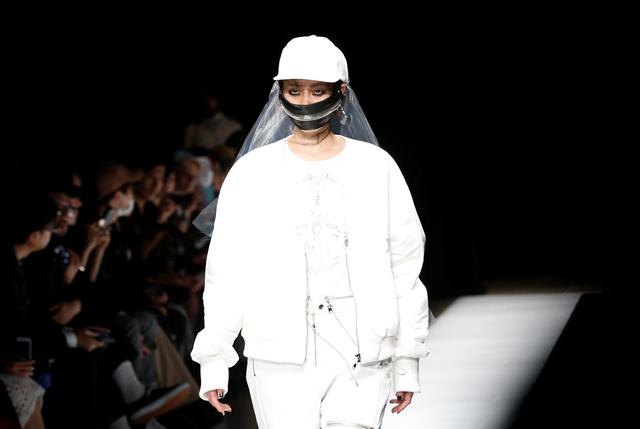You are here
Gender-bending fashion on Tokyo runway bang on trend
By AFP - Mar 25,2017 - Last updated at Mar 25,2017

A model presents creation of ACUOD by CHANU from their Autumn/Winter 2017 collection during Tokyo Fashion Week in Tokyo, Japan, on Wednesday (Reuters photo by Kim Kyung-Hoon)
TOKYO — If gender bending fashion is suddenly all the rage in the West, think Pharrell Williams promoting Chanel’s new unisex handbag, then nowhere has the look excelled more than in Tokyo.
Japan, for decades a pioneer of the androgynous look in the style of Comme des Garcons, Yohji Yamamoto and Kenzo, is spawning young designers blurring the lines expertly between masculine and feminine.
Genderless-looking boys are gaining traction in fashion circles and on the streets of Tokyo — gay, but mostly straight men who dye their hair and wear make-up — not in an effort to pass themselves off as women but to create a new standard of beauty.
“Our big theme has always been ‘unisex’,” says Takeshi Kitazawa, one half of the design duo behind trendy label DRESSEDUNDRESSED, sold by dozens of stockists in Japan and abroad.
“’Genderless’ is now really common,” he explains after his show at Tokyo Fashion Week, a parade of eight male and four female models each wearing interchangeable clothes.
Staying true to its brand name, it was a half-dressed, half-undressed look of coats and trousers slashed at the side with deep splits and men — rather than women — parading down the catwalk in bare legs.
The only snatches of femininity were small red handbags dangled from the hand or strapped across the chest, on men as well as women, or delicate lace hems and high-heeled court shoes for women.
‘Scary before’
“Isolation” and “control” were written upside down on caps, oversized 1970s-style glasses partially obscured the faces. It was not always possible to tell if it was a man or a woman — and that was the point.
“Japanese men especially are really flexible. They wear women’s brands and Japanese women are the same as well. Perhaps Japanese culture really is ‘genderless’,” said Kitazawa.
With most Japanese designers ambitious to move into markets overseas, there is no trendier time for androgynous fashion than now.
Twenty per cent of US millennials identify as something other than strictly cisgender and straight, compared to just seven per cent of baby boomers, a survey by LGBTQ advocacy group GLAAD shows.
Transgender issues are back in the political spotlight thanks to Donald Trump’s widely criticised decision to rescind US federal protections for school students to use the bathroom of their choice.
Former gold medal-winning male Olympian turned woman reality star, Caitlyn Jenner, is a household name. American actress Kristen Stewart and British model Cara Delevingne are poster children for bisexuality.
“Now it’s acceptable to discuss it. It’s acceptable to come out now. It was so scary before,” pop star Miley Cyrus told Time magazine for a cover story last week on young people redefining the meaning of gender.
No boundaries
Rei Kawakubo of Comme des Garcons fame, a pioneer of fashion androgyny, will be this spring’s subject of the Metropolitan Museum of Art’s first monographic show on a living designer since Yves Saint Laurent, the legend who put women in trousers and tuxedo jackets, in 1983.
Currently on show at the Japan Society in New York is the exhibition “A Third Gender: Beautiful Youths in Japanese Prints”, seeking to shed light on the complex rules that governed gender in early modern Japan.
It focuses on wakashu — male adolescents who were objects of sexual desire for both men and women and who appear to have constituted a distinct third gender in the Edo period.
Skirts in the form of shirt dresses, such as a tartan dressing-gown inspired number, each worn over trousers are clearly an autumn/winter 2017 Japanese trend for men as seen on the runway at Name.’s show.
ACUOD by CHANU is the brainchild of a Korean designer repelled by suits as appropriate dress for the 21st century man. He also sent down the catwalk shirt dresses, even quilted versions, worn over tight trousers.
“I want to get rid of any boundary among gender,” explains designer Chanwoo Lee.
“The mask is [part of that] as well,” he added of black leather surgical masks covered in grinning zip metallic zips in which he dressed all his models, obscuring much of their faces.
Related Articles
MOSCOW — Russian street style might not conjure up images of high glamour, but the look is making its mark on the global fashion industry, f
MILAN — Emporio Armani touched the sky with its spring summer 2019 collection by showcasing the fresh and airy looks on the runway of Milan’
HANOI — Made from delicate silk, intricately embroidered and with vast, flared sleeves: Vietnamese 19th-century outfits do not seem a perfec


















